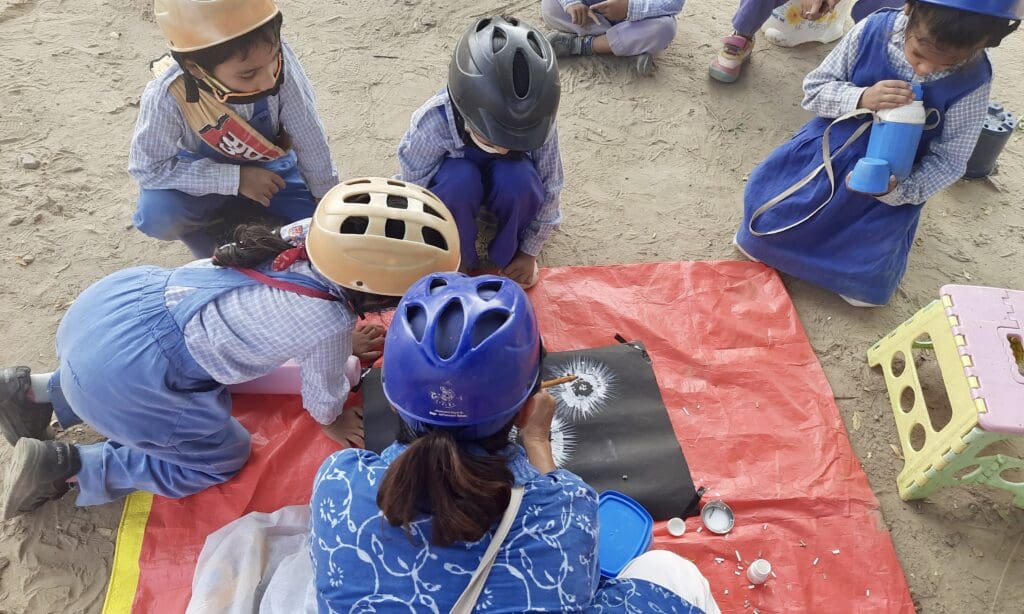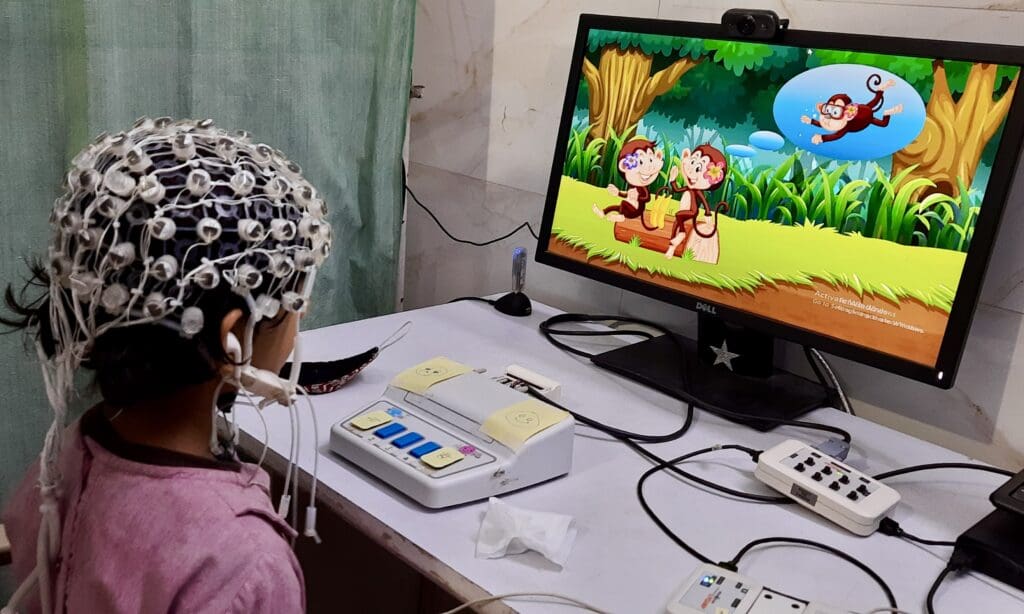
As in many countries, more children in India—up to 11 percent—are growing up with attention deficit disorder, often combined with hyperactivity. This can lead to behavioral difficulties and academic challenges. While enhanced diagnosis and awareness of mental health issues partially explain these trends, researchers also point to the isolation students experienced during the Covid-19 pandemic and the impact of technology on childrens’ ability to stay focused.
Could spending time mindfully in nature help young students cultivate greater attention? And could nature-based education further social-emotional learning (SEL) through developing skills like empathy and respect? In 2020, Mind & Life awarded a Francisco J. Varela Grant to environmental neuroscientist Pooja Sahni to find out.
“Today, when I speak to teachers and parents, they often complain that their children are restless and less attentive,” says Pooja, a researcher at the Indian Institute of Technology in Delhi. “Teachers are finding it more difficult to manage classes.” Children who fail to develop basic emotion regulation skills early-on have an even harder time navigating stressors as they get older. Through the grant, Pooja hopes to provide educators with evidence to use in developing nature-based pedagogical tools.
“When I speak to teachers and parents, they often complain
that their children are restless and less attentive. Teachers are
finding it more difficult to manage classes.”
Pooja’s interest in contemplative ecological education—pedagogy that integrates contemplative practice and nature experiences—has roots in her own childhood. Growing up in Punjab, a mostly agricultural region in Northwest India, she was never far from nature and nature-embedded practices. Her school performed an ancient Vedic ritual known as the Havan. During morning assemblies, a fire would be lit on an altar as a means of purification, and to bring awareness to negative thoughts that needed to be released. Through integrating natural elements, the ceremony promoted an ecological consciousness among students. “Now that I know the tools of science,” says Pooja, “I appreciate the effect of such rituals on my mind.”
The Mind & Life-supported study is the latest chapter in Pooja’s research investigating how our brains respond to nature. In a previous study, she found that even 15 minutes spent in nature, be it walking or gardening, can enhance people’s attention and make them less prone to distraction when undertaking tasks afterward. In short, they become more mindful. “The more nature you experience in your daily life, the more restful and attentive you tend to be,” she says.
Pooja points out that she and her collaborators are using neuroscientific tools to demonstrate what many faith traditions have affirmed for centuries—namely, nature’s value as a place for contemplation and restoration. While in ancient India, education was typically delivered outdoors, with time set aside for meditation, prayer, and/or yoga, today contemplative ecological education is largely limited to alternative schools. By exploring ways for more children to benefit from nature-based education, Pooja hopes that students in the future may reap lifelong benefits.
Engaging Children in the Study of Nature-Based Education
The study is being carried out through an unusual collaboration among neuroscientists, contemplative developmental researchers, and teachers with experience in contemplative ecological education. Specifically, the team is studying the psychosocial impact of contemplative ecological pedagogy on children. For example, can it foster less aggression and impulsivity, and more respect for nature and others? They also hope to determine the usefulness of such pedagogy in developing SEL competencies like empathy, gratitude, and self-regulation.
Using a mixed methods approach, the team plans to collect and analyze data from parent and teacher questionnaires, observations of nature-based classes and workshops, neurophysiological testing, and qualitative interviews with parents, teachers, and children. After delays imposed by the Covid pandemic, they’ve now collected preliminary data from two schools in northern India. One school, operated by the Dayalbagh Educational Institute, incorporated contemplative ecological education, while the other adhered to a standard public school curriculum.
As part of their research, the team set out to explore the extent to which kindergarteners could experience empathy for nature. With authorization secured from school administrators and parents, students were invited to participate in EEG studies—not merely as study subjects, but as research partners. “We wanted it to be fun; we wanted them to have a learning experience they’d remember for the rest of their lives,” says Pooja.

The process began with students watching a short animated video describing what they would experience. Each got to examine the EEG cap they would wear and learn how it worked. The experiment itself lasted only 15 minutes, with students given photographs to look at—for example, that of a healthy forest or animal, followed by one that was distressed. Each was asked questions while their brain activity was monitored. Based on responses from students and brain data, the team found that children expressed empathy for natural phenomena undergoing distress. Those who had grown up closer to nature showed an even greater empathetic response. In all, 83 children (ages 5 to 12) participated in the EEG study.
“We wanted it to be fun; we wanted [the students] to have a
learning experience that they’d remember for the rest of their lives.”
Next, the team will conduct a large-scale survey in schools that have successfully integrated nature-based activities into their academic curriculum. Upon conclusion of the grant, they will produce a theory of change, an outcome logic model, and research papers to be published in peer-reviewed journals. Additionally, an edited volume on alternative teaching methods for early child care and education is currently under review by Springer Nature publishers.
“It will be worth the investment of time,” says Pooja, “if we can get the findings to policymakers and, in our own small way, contribute to bringing nature back to schools and to education.”
Suggested Resources:
- Read about the impact of Mind & Life’s Francisco J. Varela Grants over two decades.
- Explore the Power of Nature-based Contemplative Practices for Inner Peace and Collective Well-being.
- Learn more about the importance of connecting students to nature in Education and the Heart of Social Change.
- Read about research being undertaken by Mind & Life PEACE grantees to find out what students and teachers think of Happiness Education in India.
Learn about one community’s experience in Bridging Contemplative Practice and Climate Action.


